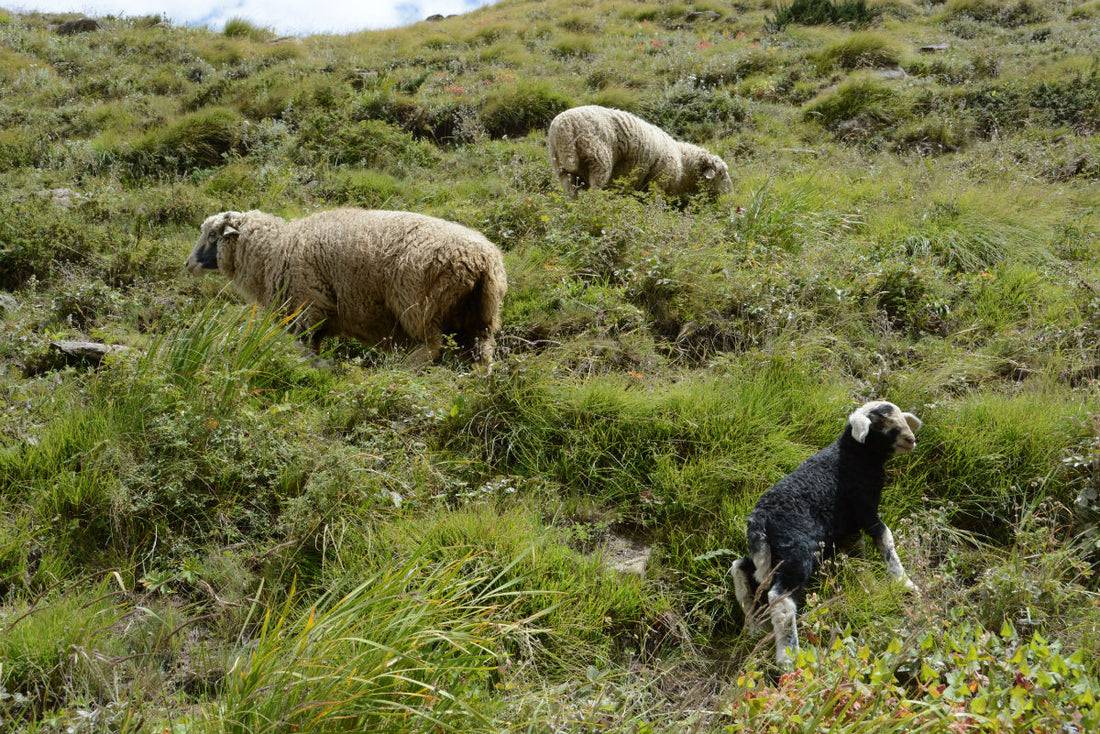The Sangla Valley is the first region in India with herds of certified organic sheep. The remote mountain valley is situated in the Indian Himalayas close to the Tibetan border. It took two years of hard work at altitudes of up to 5000 m to complete the certification process. Today sheep owners and herders are proud to be the first in India to produce pure new certified organic sheep's wool.
Tiny white dots moving slowly across the expanse of a mountain pasture, that's all you can see from a distance with the naked eye. Only once you leave the dirt road and start climbing up the steep mountain slope you can make out the hundreds of sheep with their lambs and some goats, too. Two huge, reddish-brown sheep dogs watch the herd attentively. The herders have time to brew tea over a small wood fire – they drink it which they have with fresh goat's milk and salt.
The summer pasture for this organic certified Himalana herd is situated at the end of the Sangla Valley at an altitude of about 4,000 m. It takes the herders four hours on foot to get to the nearest village, Chitkul, the last outpost of civilization this side of the border. Even though the air lacks oxygen at this altitude the men are able to walk extremely fast. The most remote summer pastures are located at altitudes of up to 5,000 m, surrounded by solitude and the snow capped peaks of the Himalayan mountain ranges. Somewhere here is the border to China and Tibet and the nearest Indian village is at least a day's journey away.
At this elevation the nights are cold even in summer but their thick coat keeps the sheep warm. From middle of September the herds make their long way to the winter pastures in lower lying, warmer valleys. Before they start their trek down the mountains the sheep are sheered and the result is the Himalana wool.
Herd, herders and dogs descend from the high mountain valleys using mule tracks. They pass Chitkul, a village with traditional wooden houses adorned with beautiful carvings. Buddhist flags fly in front of the temple with its wooden columns, entwined by long tailed dragons. Tibet is close. Now, at the beginning of September, the villagers bring in the hay that will feed the cows over winter. Chitkul will be snowed in for several months and at times totally cut off from the rest of the world.
As the herds get closer to the lower end of the Sangla Valley the landscape changes: sheltered from the worst of the cold and too much rain by high mountains and steep rock faces, apricot and almond trees grow. The changing climate has apple trees flourishing at an altitude of 3000 m. Apart from sheep farming the orchards are the most important source of income for the farmers in the valley.
The economy in the Sangla communities has only picked up since the valley has become accessible by road. Picture a single lane, potholed track, with hairpin bends, sometimes blasted into the vertical rock face or crumbling on the edges, too narrow for two cars to pass each other except at special laybys. Now it's a three hour drive to Peo, the district capital, where farmers sell produce like fruit and peas and where they bring wool for processing. And of course all essential goods needed in the valley, from cooking oil to building materials like cement or bricks, all has to be brought up this treacherously narrow road that often leaves no more than a hand's width of space between the tires and the abyss.
To get to the plains, some 350 km to the south takes at least two days by car – along endlessly winding roads and across dozens of mountain passes. The Himalana sheep, the herders and their dogs cover the same distance to get to the allocated winter pastures. On average it takes eight weeks to complete the journey from the summer pastures in the Sangla Valley to the low lying winter pastures in Nahan. Until the end of April the sheep will stay on the pastures in the open, government managed forests. After another sheering they will again set off and it will be June until they reach the mountain pastures at the roof of the world.

